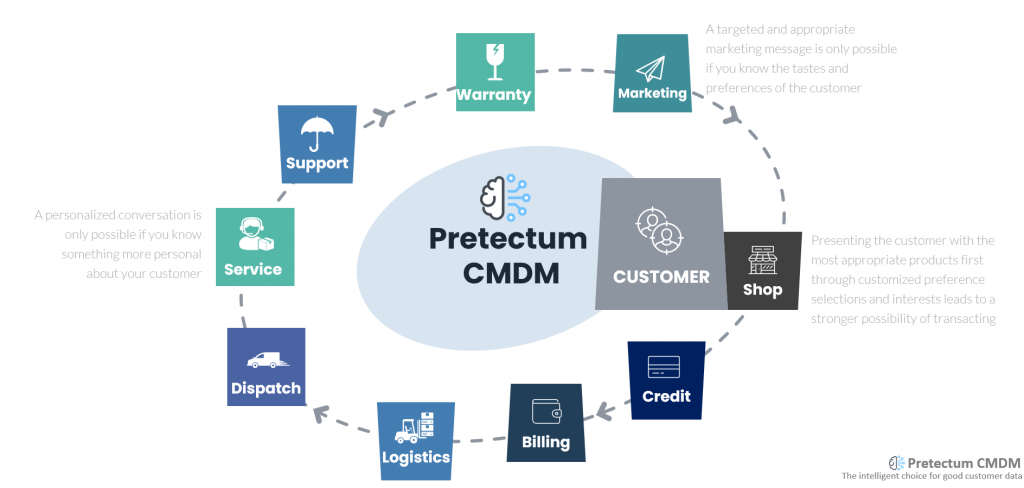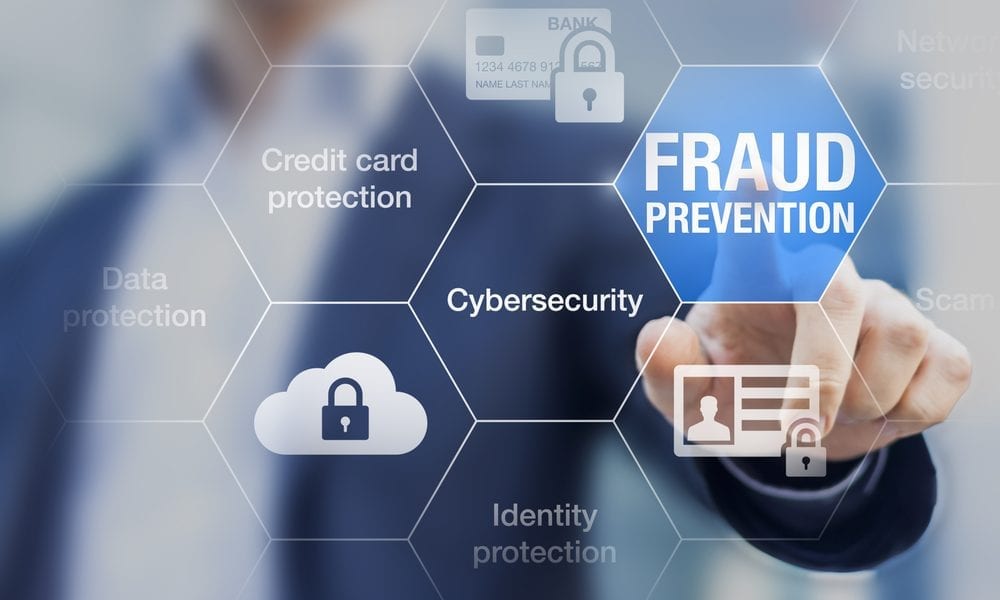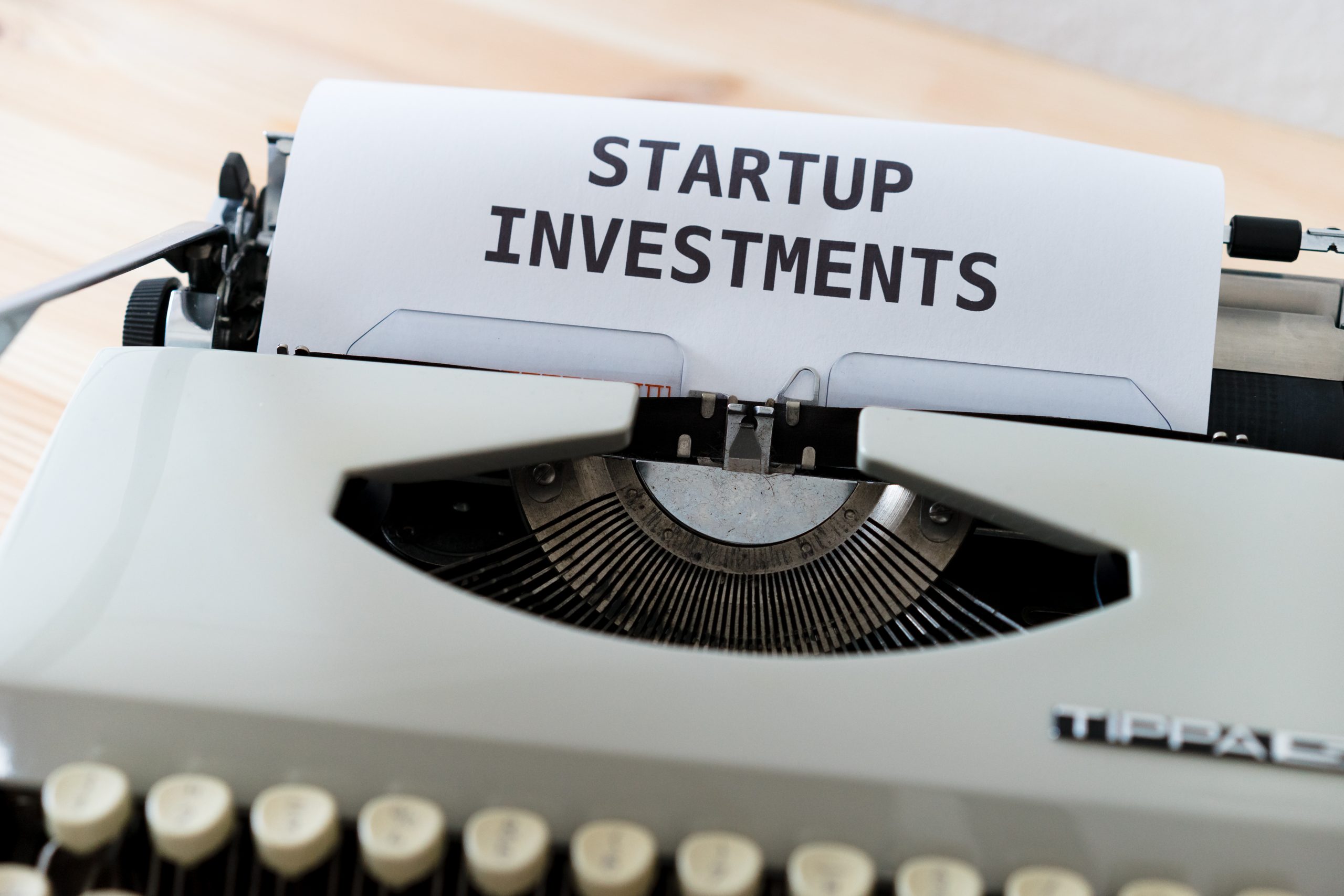Utilizing Pretectum CMDM for cross-channel marketing and customer engagement
Contemporary business demands dynamism and the convergence of customer data and marketing programs is essential for organizations looking to enhance customer engagement and at the same time, drive successful cross-channel marketing campaigns.
As organizations wrestle with challenging integration problems and try to use customer data across their different operations channels, we believe the Pretectum CMDM can offer organizations a transformative alternative solution. Our innovative platform supports federated customer data management, centralizes customer master data and empowers organizational business units in order to make better use of the full potential, of their customer data. They can also do this for more personalized and more effective cross-channel marketing strategies.
Customer Data and Marketing
The relationship between customer data and marketing has never been more pivotal for marketing campaign success. Organizations rarely stay focused on a single channel and need to expand reach, sometimes entering channels previously unexplored, these range from social media, and email to traditional advertising and e-commerce platforms. The need for a unified and accurate view of the customer profile is key to campaign cost-effectiveness, minimizing customer annoyance and intrusiveness. In the absence of a centralized customer master, these are all very real risks. Organizations that do not have a centralized customer master data management program, often find themselves wrestling with departmental or system data silos, inconsistency in customer profiles, and forfeited opportunities for cost-optimized targeted engagement.
Pretectum CMDM is a solution designed not just for customer data management but also as a lever for elevating improved cross-channel marketing and customer engagement.
The CMDM system’s ability to centralize and harmonize customer data sets the stage for a seamless, personalized, and effective marketing approach.

Key Features of Pretectum CMDM that might be compelling for for Cross-Channel Marketing include:
360-Degree Customer Views: Pretectum CMDM aggregates customer data from whichever sources you integrate, as touchpoints and channels of data that, when combined, provide a unified view of the customer profile. This 360-degree customer view is a key for crafting lower friction personalized marketing campaigns serving up the opportunity to personalize messaging that will resonate in alignment with individual preferences and customer tracked behaviors.
Data Enrichment and Cleansing: Ensuring the accuracy and completeness of customer data is imperative for successful marketing initiatives. The CMDM system’s integration with data enrichment and cleansing capabilities helps you to refine and enhance the customer profiles, this in turn enables marketers to work with higher-quality data for better targeted and more effective campaign execution.

Segmentation and Targeting: Pretectum CMDM empowers marketers with the opportunity to undertake advanced data segmentation. By categorizing customers based on attributes, behaviours, and preferences, organizations can tailor marketing messages to data-specific segments, enhancing the relevance and impact of their marketing outreach campaigns.
Personalization at Scale: Achieving personalization at scale is challenging for many organizations. Many try to do this with spreadsheets and small databases but quickly reach the limits of those technologies. Pretectum CMDM addresses this by providing the infrastructure for personalized marketing automation. From personalized email campaigns to targeted social media advertisements, the CMDM system ensures that each customer interaction is able to be made as relevant and meaningful as practically possible.
Cross-Channel Campaign Orchestration: Coordinating marketing efforts across multiple channels is complex when working with differently shaped data that purports to represent the same entities But coordination is essential for an integrated and low-friction customer experience.
The Pretectum CMDM supports cross-channel campaign orchestration, by ensuring consistency and coherence in unified customer data profiles and this can align with the organization’s cost-optimized branding intentions in support of diverse platforms.
The implementation task
Successful integration of any CMDM system into an organization’s cross-channel marketing strategy involves a strategic and phased approach. Some key steps need to be undertaken to implement CMDM to the greatest effect in cross-channel marketing:
Mapping Customer Journeys: Before implementation, you must understand and map how your customer data enters your systems, where it gets used and where it could be used further. This involves identifying data capture points, systems, and triggering events. You will also want to understand the kinds of customer data that you want to capture and the types of preferences, and potential pain points that would be advantageous to know about. Mapping the customer data acquisition and use journey provides insights into where and how CMDM-system-bound initiatives can be most impactful.
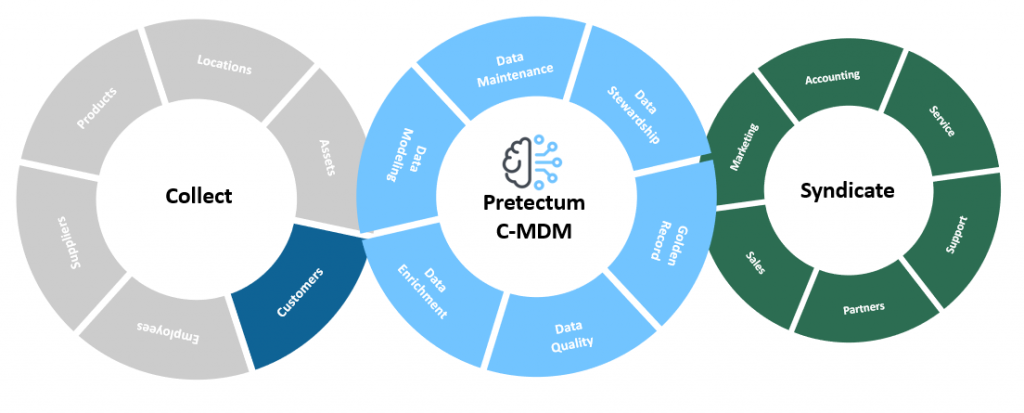
Data Integration and Profiling: The Pretectum CMDM’s data integration capabilities are key to not just integrity but leverage for various customer data holding systems. Organizations that focus on integrating data from different sources and then profile it for quality, ensure that clean and enriched datasets are always in use for marketing activities.
Defining Customer Segments: Using the systems query building features, an organization can define customer segments based on demographics, behaviours, and preferences, in fact any data attribute that makes sense in segmentation These segments serve as the foundation for targeted marketing campaigns, allowing organizations to deliver content that resonates with specific audience segments.
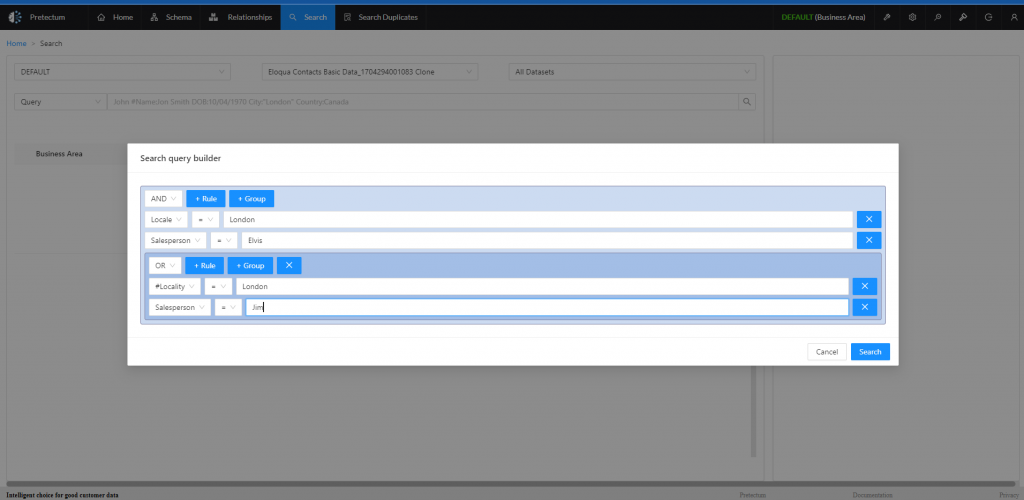
Personalization Strategy: With CMDM in place, organizations can craft a robust personalization strategy. This involves tailoring content, offers, and messages to align with the preferences and behaviors of specific customer segments. Personalization fosters, in the customer, a sense of connection and relevance, with the potential to drive enhanced customer engagement.
Automation and Orchestration: Leveraging CMDM system automation capabilities, organizations can automate data extraction, preparation and syndication. From triggering personalized emails based on customer interactions to synchronizing data exchanges across platforms, automation ensures consistency and efficiency in marketing efforts.
Analytics and Optimization: Your implementation process should include setting up analytics to measure the effectiveness of cross-channel marketing campaigns. CMDM’s analytics tools provide insights into customer engagement, conversion rates, and other key metrics. This data, in turn, informs ongoing optimization efforts for continuous improvement.
Driving toward positive outcomes
A 360-degree view of customers benefits the organization and the customer, with the Pretectum CMDM your organization gets to deliver personalized and cohesive experiences across all enabled channels. This enhances customer satisfaction and loyalty, fostering long-term relationships.
Segmentation and personalization within the platform enhance the effectiveness of tightly targeted campaign management. Your targeted messaging is more likely to resonate with specific audience segments, leading to higher engagement rates and improved conversion outcomes.
Automation and orchestration features streamline the management of the customer data. Teams can save time and resources by having their data load and syndicate tasks automated thereby allowing them to focus more of their efforts on strategy and creativity.
Cross-channel marketing often involves multiple teams and platforms. The platform ensures consistent customer profile management in one place, preventing conflicts or different information across the different channels. This unified experience builds trust and reinforces confidence in your data governance practices both within the organization and
The CMDM system’s querying capabilities mean your teams can make data-driven decisions – this means optimized strategies. Insights derived from customer data can related to behaviour, sentiment, campaign participation or anything the business cares about. The data made us of, could be anything that enables marketers to refine their approaches and adapt to evolving market dynamics.

Case Studies
Real-world Success with Customer Master Data Management
Case Study 1: ECommerce Webshop Platform
An e-commerce platform faced challenges in delivering personalized recommendations to its diverse customer base. Implementing a hub and spoke deployment of Customer Master Data Management allowed the platform to serve from a unified customer data master, enabling precise segmentation and personalized recommendations. This resulted in a significant increase in conversion rates and customer satisfaction.
Case Study 2: Global Brand Messaging Campaign Optimization
A global brand sought to streamline its cross-channel marketing efforts, spanning social media, email, and online advertising. The centralised Customer Master Data Management System forced a centralized approach to customer data, ensuring consistent customer profiles and supplementary personalization attributes across all the outbound marketing channels. The brand experienced improved engagement and a notable boost in campaign performance metrics.
As your organization pushes further to handle the ever-shifting business landscape, the role of a robust data management solution needs to be acknowledged. Pretectum’s CMDM platform addresses the challenges posed by disparate data sources and serves as an opportunity to catalyse the elevation of marketing strategies to new heights.
CMDM is not just about technology; it’s about creating meaningful connections with customers. Leveraging CMDM’s capabilities for centralized data management, organizations overcomes the limitations of traditional marketing approaches and tooling, delivering the opportunity for more personalized and impactful campaigns that resonate with hyper-refined audiences.
The journey toward enhanced customer engagement starts with the strategic adoption of Pretectum CMDM—a journey that promises not only marketing success but also lasting customer relationships in an increasingly aggressive and competitive landscape enabled by digital practices. Those who choose to do nothing will be left behind.


